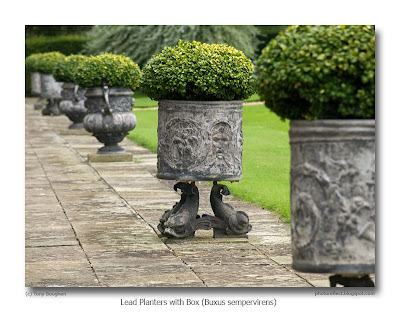 click photo to enlarge
click photo to enlargeLeadwork in architecture became increasingly popular in the 1400s when church roof pitches were made shallower, and the thatch, tile and shingle coverings were replaced by large sheets of lead. In the seventeenth century lead was widely used for drainpipes, rainwater heads, and lining the valleys between adjoining pitched roofs. Water cisterns were also constructed out of the metal.
It was during this century that the practice of embellishing rainwater heads with the date of construction, paterae, swags and the like, began. The accession of William and Mary brought Dutch styles to England, including a taste for garden statues made out of lead. Classical goddesses, mythical beasts and portrait busts made of lead peered out of parterres and knot gardens alongside those made of stone. London lead yards, often run by Dutchmen such as John van Nost, also turned out garden urns made of lead. These were based on classical Greek and Roman examples, and were usually decorated with masks, leaves, flowers, swags, or historical friezes with people and animals. The popularity and duarability of these urns was such that they continued being made into the eighteenth century and even down to the present day. Cylindical and square planters were made, as well as more traditional urns, and country house owners and more prosperous urban dwellers bought them in sets to place next to doors, as eye-catching features in gardens, or in rows along terraces and paved areas, as in the example above.
Some of the planters shown in the photograph, which was taken at a Lincolnshire country house, are dated - 1714 - as I recall, showing the long-lasting properties of these interesting containers. Here they are filled with closely cut box, and gaze across a lawn at a topiarized hedge with peacocks and other fanciful shapes. I took my photograph from one end of the line of planters, and focused on the second, ensuring it was the only sharp example in the row.
photograph & text (c) T. Boughen
Camera: Olympus E510
Mode: Aperture Priority
Focal Length: 119mm (238mm/35mm equiv.)
F No: f6.3
Shutter Speed: 1/100
ISO: 100
Exposure Compensation: 0 EV
Image Stabilisation: On